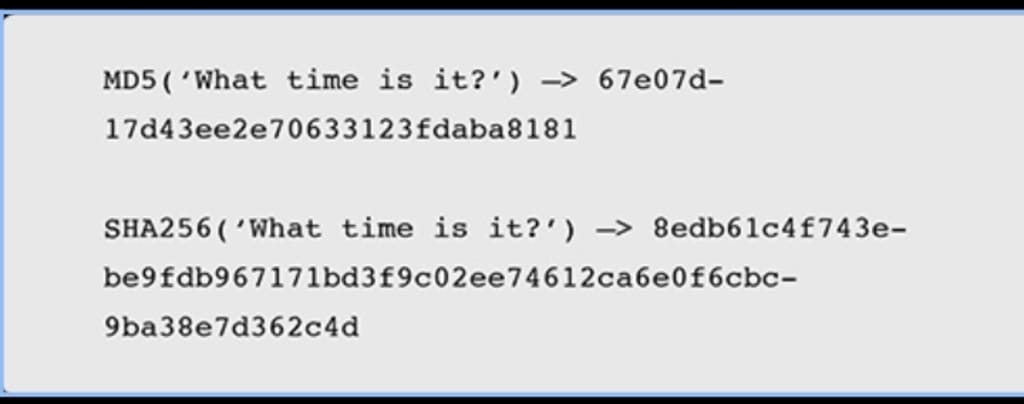
A hash function is a series of mathematical steps or algorithms that you can perform on some input data, resulting in a fingerprint, or digest, or simply, a hash. There are basic hash functions (not used in blockchains) and cryptographic hash functions (used in blockchains).
We’ll need to understand basic hash functions before moving to cryptographic hash functions.
Basic Hash Function
A really basic hash function might be ‘Use the first character of the input’. So using this function you’d get: Hash(‘What time is it?’) => ‘W’
The input to this function is ‘What time is it?’ and is sometimes called the
preimage or the message.
The output of this function is ‘W’ and is called the digest, the hash value, or simply the hash.
Hash functions are deterministic because the output is determined by the input. If a function is deterministic, it always produces the same output for any given input. All mathematical functions are deterministic (adding, multiplying, dividing, etc).
Cryptographic Hash Functions A cryptographic hash function is special and has some characteristics that makes it useful in cryptography and for cryptocurrencies, as we will see later.
Wikipedia70 states that the ideal cryptographic hash function has five main properties (my comments in parentheses): 1. It is deterministic so the same message always results in the same hash 2. It is quick to compute the hash value for any given message (you can easily go ‘forwards’) 3. It is not
feasible to generate a message from its hash value except by trying all possible messages (you can’t go ‘backwards’) 4. A small change to a message should change the hash value so extensively that the new hash value appears uncorrelated with the old hash value (a small change makes a big difference) 5.
It is not feasible to find two different messages with the same hash value (it is hard to create a hash clash) What does this mean? The combination of properties 2 (you can easily go ‘forwards’) and 3 (you can’t go ‘backwards’) means that cryptographic functions are sometimes called ‘trapdoor function’. It is easy to create a hash from a message, but you can’t re-create the input from the hash. Nor can you guess or infer what the message may be by looking at the hash (property 4). The only way to go backwards is to try every possible combination of inputs and see if the hash value matches the one you are trying to reverse. This is called a brute force attack.
So would our previous hash function (‘Use the first character’) be a good cryptographic hash function? Let’s see: 1. Yes, it is deterministic. ‘What time is it?’ always hashes to ‘W’.
Yes, it is quick to compute the output, you simply take the first character.
Yes, by knowing only ‘W’ it is not feasible to guess the original sentence (but see 5).
No, a small change in the message doesn’t necessarily change the output. ‘What time is at?’ also hashes down to ‘W’.
No, we can easily create loads of inputs that will all hash down to the same output. Anything starting with ‘W’ will work.
So our earlier hash function is no good as a cryptographic hash function.
So what is a good cryptographic hash function? There are some established industry standard cryptographic hash functions that meet all of these criteria. They have names like MD571 (Message Digest) or SHA-256 (Secure Hash Algorithm), and they have an additional benefit in that
their output is usually of a fixed length. This means that whatever you use as an input to the hash function, whether it is a sentence, a file, a hard drive, or an entire data centre, you will always get a short digest back.






Comments
There are no comments for this story
Be the first to respond and start the conversation.